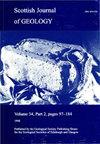来自Ne和Ar同位素的High Possil和Strathmore陨石的空间历史
IF 1.3
4区 地球科学
Q4 GEOLOGY
引用次数: 0
摘要
High Possil和Strathmore L6球粒陨石分别于1804年和1917年在苏格兰坠落。解开它们的宇宙射线暴露(CRE)年龄提供了关于它们何时从母体喷出、如何被输送到地球的关键信息,对于理解太阳系中小天体的动力学至关重要。在这里,我们使用Ne和Ar同位素组成的新测量来确定这两颗陨石的CRE年龄。重复的宇宙成因21Ne和38Ar浓度产生44.6的CRE年龄 ± 4.6 Ma表示高位和15.4 ± 1.3 马代表斯特拉斯莫尔。这些与L6球粒陨石弹射记录中已确定的峰值一致。它们产生超过3.15的40Ar气体保留年龄 Ga,这与小行星解体时起源于母体深处的两颗陨石一致。主题集:本文是早期职业研究集的一部分,可在以下网站获取:https://www.lyellcollection.org/cc/SJG-early-career-research本文章由计算机程序翻译,如有差异,请以英文原文为准。
Space history of the High Possil and Strathmore meteorites from Ne and Ar isotopes
The High Possil and Strathmore L6 chondrites fell in Scotland in 1804 and 1917 respectively. Unravelling their cosmic-ray exposure (CRE) ages provides crucial information about when they were ejected from the parent body, how they were delivered to Earth and is ultimately important for understanding the dynamics of small bodies in the solar system. Here we use new measurements of the Ne and Ar isotopic composition to determine CRE ages of both meteorites. Duplicated cosmogenic 21Ne and 38Ar concentrations yield CRE ages of 44.6 ± 4.6 Ma for High Possil and 15.4 ± 1.3 Ma for Strathmore. These coincide with well-established peaks in the ejection record for the L6 chondrites. They yield 40Ar gas retention ages in excess of 3.15 Ga, which is consistent with both meteorites originating at depth within the parent body at the time of asteroidal break-up. Thematic collection: This article is part of the Early Career Research collection available at: https://www.lyellcollection.org/cc/SJG-early-career-research
求助全文
通过发布文献求助,成功后即可免费获取论文全文。
去求助
来源期刊

Scottish Journal of Geology
地学-地质学
CiteScore
1.70
自引率
0.00%
发文量
10
审稿时长
>12 weeks
期刊介绍:
Although published only since 1965, the Scottish Journal of Geology has a long pedigree. It is the joint publication of the Geological Society of Glasgow and the Edinburgh Geological Society, which prior to 1965 published separate Transactions: from 1860 in the case of Glasgow and 1863 for Edinburgh.
Traditionally, the Journal has acted as the focus for papers on all aspects of Scottish geology and its contiguous areas, including the surrounding seas. The publication policy has always been outward looking, with the Editors encouraging review papers and papers on broader aspects of the Earth sciences that cannot be discussed solely in terms of Scottish geology.
The diverse geology of Scotland continues to provide an important natural laboratory for the study of earth sciences; many seminal studies in geology have been carried out on Scottish rocks, and over the years the results of much of this work had been published in the Journal and its predecessors.
The Journal fully deserves its high reputation worldwide and intends to maintain its status in the front rank of publications in the Earth sciences.
 求助内容:
求助内容: 应助结果提醒方式:
应助结果提醒方式:


